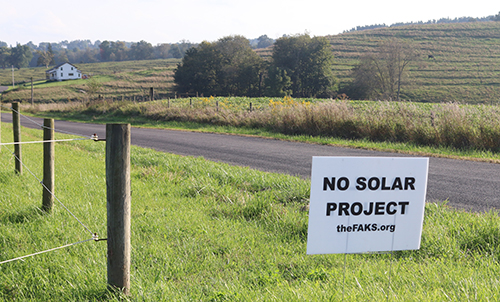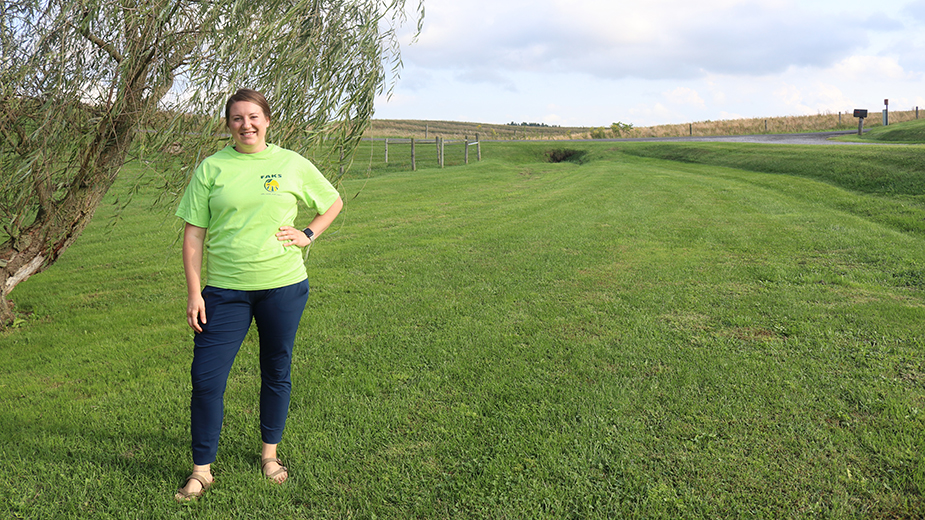SUMMITVILLE, Ohio – When residents of Summitville look across the rolling hills surrounding their village, they are accustomed to seeing cattle grazing and soybeans and corn growing tall in the fields.
But the proposed Kensington Solar Project could mean views of 7-foot tall fences and fields of solar panels for at least 61 households.
For Katie Kampfer, who lives with her husband and three sons on the same land where her family has farmed for generations, it all became real when nearby fields were plowed in striped patterns for archeological studies earlier this year.
Now the field across from her home has noticeable stripes, as do many fields near the 600 acres her family farms. The nearby St. John’s Catholic Church and many of her neighbors’ homes are also visible within distance of striped fields, which are proposed sites for the project.
“When they plowed you could see the over 2,000 acres of plowing and it made it kind of scary,” Kampfer says. “You think you own enough acres that you would be good to go. And I would never have assumed that the farm that surrounds us would ever have leased.”
The Kensington Solar Project proposed by Liberty Power, a subsidiary of Algonquin Power of Oakville, Ontario, Canada, would construct rows of 13-foot tall solar panels. There are 2,264 acres listed as a part of the project, which Kampfer and others in opposition have noted is about one-sixth of the entirety of Franklin Township and nearly surrounds the village of Summitville. It is estimated the acreage where the panels will be placed is roughly 856 football fields of farmland.
Summitville is not alone. Across the state, Kampfer says there are 52 solar projects proposed with a combined 92,000 acres, most of which is land devoted to agriculture.
“Green energy is great. But you need to eat too,” Kampfer says. “There are ways to do it without taking 92,000 acres of farmland away from people.”
Liberty Power finished its application Aug. 12 and awaits permitting decisions by the Ohio Power Siting Board.
According to Iman Zeidan, the Kensington Solar Energy Centre project manager, once the final permit is granted, the project could begin the third quarter of 2023. It would take eight months to a year to construct the solar arrays.
The construction phase would employ 150 to 200 people. The project would install medium-voltage collection lines underground and more than 42,800 I-beams to support the solar panels. The application states that fences would be placed around the project areas and interior access roads created.
In addition, there would be a project substation, which would send all the electricity into the electric grid through the ATSI Congress-Toronto 135kV (kilovolt) transmission line.
Once completed, the project is anticipated to employ five to 10 people permanently and generate up to 145MW of power.
Besides generating jobs and electric power, Zeidan says the company plans to invest in and support the local community, including road use agreements to maintain and improve the roads. The company has included setbacks in the designs and incorporated visual mitigation for those who would have a direct view of the project.
Liberty Power is working to submit a payment in lieu of taxes (Pilot) application with Columbiana County, which would provide funds annually to all the taxing districts in the area of the project, Zeidan says.
Although some have questioned whether solar panels are even feasible in northeastern Ohio, where cloudy days prevail, Zeidan indicates panels work fine during overcast and rainy days, although not as efficiently as during days of full sun.
According the U.S. Office of Energy Efficiency and Renewable Energy, the amount of solar-collected energy can be affected by tilting of the earth, the time of day and amount of cloud cover. The southwestern United States is positioned to generate the greatest amount of solar energy.
OPPOSITION GROWING

Besides numerous community members putting out signs against the project, the Columbiana County commissioners recently passed a resolution opposing the Kensington Solar Project, although Commissioner Tim Weigle abstained. As someone who will get a vote when the Ohio Power Board meets to make the final decision, Weigle says he did not feel it was appropriate for him to weigh in at this time.
The resolution states that the properties involved in the project have historically been agricultural and forested land. By surrounding the village of Summitville with solar panels, the project would inhibit future expansion and economic development in the village and in Franklin Township.
Concerned residents in the township, including Diana Brown, who is Kampfer’s mother, and Henry Bergfeld, a former long-time manager of Summitcrest Farms, one of the properties where the solar panels are slated to go, have attended several county commissioners’ meetings to voice their concerns.
Forming the group Franklin Against Kensington Solar (FAKS), they have collected more than 225 signatures of concerned residents in a township with a population of 780. The group has held three public meetings to give residents a chance to learn more about the status of the proposed project.
Most of what they know, they learned after reading the permit application that Liberty Power filed. The company paid the $67,500 application fee and had the application verified as complete on Aug. 12. The timeline for setting a hearing of the Ohio Power Board is 60 to 90 days from then and that hearing has yet to be scheduled.
Kampfer, Brown and others in FAKS plan to go to the hearing to speak about why they believe this is not the right place for the project.
Brown is concerned about the noise, she says, and the truck traffic from installing the solar fields, the creation of the access roads and the 39 miles of fencing that will surround it.
Already there are problems with wildlife, she says, such as an overabundance of deer that eat crops in the area. Besides deer, she says, there are also eagles, bear and bobcats in the township. Fencing off larger portions may only disrupt the migration patterns of the animals and push those populations of deer closer together.
Additionally, the group is concerned about whether there will be runoff from the installation process and detergent used to clean the panels. Kampfer’s cattle drink from a creek just down the hill from where solar panels are projected to go on the neighbor’s fields. Homes in the area are served by well water, not municipal services.
The property leases are for 35 years and once the lifespan of the solar panels ends, Zeidan indicates the project would be decommissioned. That includes removing all the aboveground features and buried structures down to five feet below the ground, as well as disposing offsite or recycling the solar panels and other materials needed to build the arrays.
Only those access roads that the property owners still want would remain, as well as the substation, interconnection facility and other utility facilities not owned by the project. The properties would be returned to original topography with soil remediated and returned to its predevelopment state so agriculture can resume.
Kampfer questions even if the decommissioning does happen, who would remain to farm the properties? She sees an entire generation of farmers being lost, people who would no longer gain the expertise and the expensive equipment to resume farming.
Kampfer farms some of the same property her family did when she was a child, the same property her paternal grandparents farmed. She and her husband, who grew up on a nearby farm, learned from family and they are starting to teach some of those things to her three sons, ages 5, 3 and 1.
Brown says she was happy when her daughter chose to remain in the area and farm with her husband. In turn, Kampfer hopes one of her children will chose to farm and live in the area when he grows up. With a growing family and only one bathroom, she also would like to add onto the farmhouse where she grew up.
Should the Kensington Solar Project happen, she does not see either thing happening.
Pictured at top: Katie Kampfer stands in her yard. The field across the road is one of the projected sites of the Kensington Solar project.
